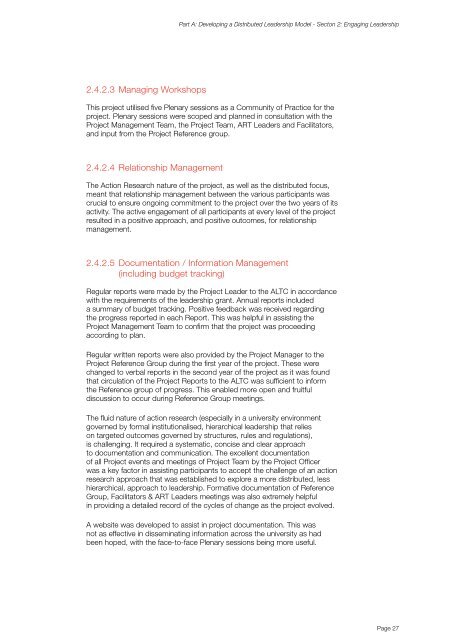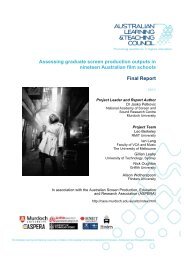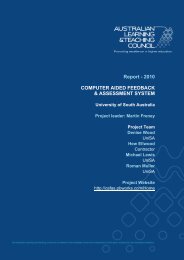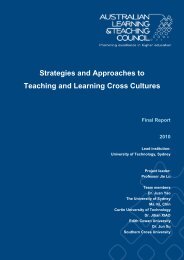student feedback and leadership - Office for Learning and Teaching
student feedback and leadership - Office for Learning and Teaching
student feedback and leadership - Office for Learning and Teaching
Create successful ePaper yourself
Turn your PDF publications into a flip-book with our unique Google optimized e-Paper software.
Part A: Developing a Distributed Leadership Model - Secton 2: Engaging Leadership2.4.2.3 Managing WorkshopsThis project utilised five Plenary sessions as a Community of Practice <strong>for</strong> theproject. Plenary sessions were scoped <strong>and</strong> planned in consultation with theProject Management Team, the Project Team, ART Leaders <strong>and</strong> Facilitators,<strong>and</strong> input from the Project Reference group.2.4.2.4 Relationship ManagementThe Action Research nature of the project, as well as the distributed focus,meant that relationship management between the various participants wascrucial to ensure ongoing commitment to the project over the two years of itsactivity. The active engagement of all participants at every level of the projectresulted in a positive approach, <strong>and</strong> positive outcomes, <strong>for</strong> relationshipmanagement.2.4.2.5 Documentation / In<strong>for</strong>mation Management(including budget tracking)Regular reports were made by the Project Leader to the ALTC in accordancewith the requirements of the <strong>leadership</strong> grant. Annual reports includeda summary of budget tracking. Positive <strong>feedback</strong> was received regardingthe progress reported in each Report. This was helpful in assisting theProject Management Team to confirm that the project was proceedingaccording to plan.Regular written reports were also provided by the Project Manager to theProject Reference Group during the first year of the project. These werechanged to verbal reports in the second year of the project as it was foundthat circulation of the Project Reports to the ALTC was sufficient to in<strong>for</strong>mthe Reference group of progress. This enabled more open <strong>and</strong> fruitfuldiscussion to occur during Reference Group meetings.The fluid nature of action research (especially in a university environmentgoverned by <strong>for</strong>mal institutionalised, hierarchical <strong>leadership</strong> that relieson targeted outcomes governed by structures, rules <strong>and</strong> regulations),is challenging. It required a systematic, concise <strong>and</strong> clear approachto documentation <strong>and</strong> communication. The excellent documentationof all Project events <strong>and</strong> meetings of Project Team by the Project <strong>Office</strong>rwas a key factor in assisting participants to accept the challenge of an actionresearch approach that was established to explore a more distributed, lesshierarchical, approach to <strong>leadership</strong>. Formative documentation of ReferenceGroup, Facilitators & ART Leaders meetings was also extremely helpfulin providing a detailed record of the cycles of change as the project evolved.A website was developed to assist in project documentation. This wasnot as effective in disseminating in<strong>for</strong>mation across the university as hadbeen hoped, with the face-to-face Plenary sessions being more useful.Page 27
















